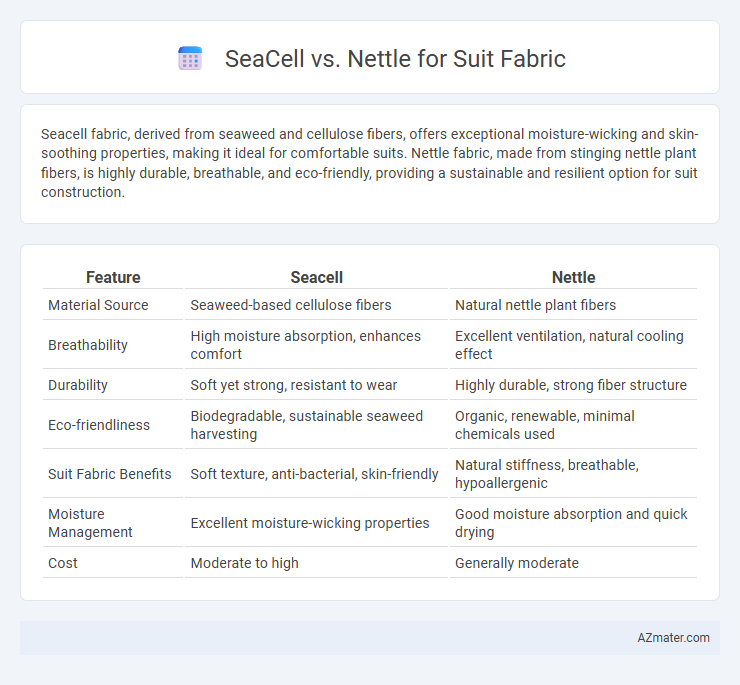Seacell fabric, derived from seaweed and cellulose fibers, offers exceptional moisture-wicking and skin-soothing properties, making it ideal for comfortable suits. Nettle fabric, made from stinging nettle plant fibers, is highly durable, breathable, and eco-friendly, providing a sustainable and resilient option for suit construction.
Table of Comparison
| Feature | Seacell | Nettle |
|---|---|---|
| Material Source | Seaweed-based cellulose fibers | Natural nettle plant fibers |
| Breathability | High moisture absorption, enhances comfort | Excellent ventilation, natural cooling effect |
| Durability | Soft yet strong, resistant to wear | Highly durable, strong fiber structure |
| Eco-friendliness | Biodegradable, sustainable seaweed harvesting | Organic, renewable, minimal chemicals used |
| Suit Fabric Benefits | Soft texture, anti-bacterial, skin-friendly | Natural stiffness, breathable, hypoallergenic |
| Moisture Management | Excellent moisture-wicking properties | Good moisture absorption and quick drying |
| Cost | Moderate to high | Generally moderate |
Introduction to Sustainable Suit Fabrics
Seacell and Nettle fibers represent innovative sustainable suit fabric options, offering eco-friendly alternatives to traditional materials. Seacell, derived from seaweed and wood pulp, provides natural moisture-wicking and skin-soothing properties, while Nettle fabric is made from nettle plant fibers known for durability and breathability. Both fabrics contribute to reducing environmental impact by utilizing renewable resources and promoting biodegradable textiles in the fashion industry.
Overview of Seacell: Origin and Production
Seacell fabric originates from natural cellulose fibers derived from wood pulp infused with sustainably harvested seaweed, primarily sourced from the coastlines of Norway and Ireland. Its innovative production process involves embedding seaweed particles into the fiber matrix, which remains intact within the yarn, offering skin-soothing and antimicrobial properties ideal for suit fabrics. This blend of eco-friendly materials and advanced manufacturing highlights Seacell as a unique, functional textile compared to traditional nettle fibers used in suit production.
Nettle Fiber: Historical Context and Benefits
Nettle fiber, historically used for centuries in Europe and Asia, offers durable and eco-friendly qualities ideal for suit fabrics. Its natural breathability and moisture-wicking properties ensure comfort, while its strength provides long-lasting wear compared to Seacell, which is more valued for its softness and skin benefits. Sustainable cultivation of nettle fiber also reduces environmental impact, making it a preferred choice for eco-conscious tailoring.
Environmental Impact: Seacell vs Nettle
Seacell fabric, derived from renewable seaweed and eucalyptus fibers, offers a low environmental footprint through biodegradable properties and minimal water consumption during production. Nettle fabric, sourced from durable wild nettle plants, is highly sustainable due to its organic cultivation without pesticides and ability to grow on poor soil, enhancing soil health and reducing resource use. Comparing the two, Seacell emphasizes ocean-based regenerative materials while Nettle supports land-based eco-friendly farming, both contributing to reduced textile industry pollution and resource depletion.
Comfort and Breathability Comparison
Seacell fabric incorporates seaweed fibers that provide natural moisture-wicking properties and enhanced softness, resulting in a highly comfortable suit fabric. Nettle fabric, made from stinging nettle fibers, offers excellent breathability and durability, but with a firmer texture compared to Seacell. When comparing comfort and breathability, Seacell suits excel in softness and moisture management, while nettle suits provide superior airflow and strength for long-lasting wear.
Durability and Longevity in Suit Fabrics
Seacell suit fabric offers excellent durability due to its incorporation of seaweed fibers, which provide natural strength and resistance to wear over time. Nettle fabric is renowned for its robust and long-lasting qualities, often outperforming traditional fibers with its high tensile strength and abrasion resistance. Both fabrics ensure longevity for suits, but nettle tends to offer superior durability, making it ideal for garments requiring frequent use and resilience.
Aesthetic Qualities: Look and Feel
Seacell fabric offers a smooth, silky texture with a subtle sheen, enhancing the visual appeal and providing a luxurious feel suitable for high-end suits. Nettle fabric features a coarse yet refined texture with a natural matte finish, delivering a rustic aesthetic that emphasizes durability and eco-conscious style. Suit fabric made from Seacell prioritizes elegance and softness, while nettle suits highlight texture-rich, breathable qualities with an organic look.
Skin Health and Hypoallergenic Properties
Seacell fabric, infused with seaweed fibers rich in antioxidants and vitamins, promotes skin regeneration and soothes irritation, making it highly beneficial for sensitive skin. Nettle fabric, derived from stinging nettle plants, offers natural antibacterial and hypoallergenic properties that help reduce allergic reactions and skin inflammation. Both fabrics are eco-friendly and breathable, but Seacell is particularly favored for its enhanced skin-nourishing effects, while nettle fabric excels in minimizing dermatitis and allergic responses.
Price and Market Availability
Seacell fabrics, known for their eco-friendly seaweed-infused fibers, typically come at a higher price point due to sustainable production methods, limiting widespread market availability. Nettle fabric, derived from nettle fibers, offers a more affordable alternative with growing availability in niche eco-conscious markets. Both materials appeal to sustainable fashion but differ significantly in cost and distribution channels within the suit fabric industry.
Conclusion: Choosing the Right Eco-Friendly Suit Fabric
Seacell fabric offers exceptional moisture-wicking and antibacterial properties derived from seaweed, making it ideal for long-lasting freshness and comfort in suits. Nettle fiber provides remarkable durability and breathability, sourced from eco-friendly nettle plants that require minimal water and pesticides. Choosing between Seacell and Nettle depends on prioritizing moisture management with a silky texture or opting for robust, sustainable wear with natural breathability in eco-friendly suit fabrics.

Infographic: Seacell vs Nettle for Suit Fabric
 azmater.com
azmater.com